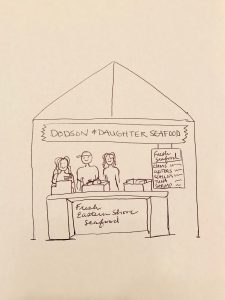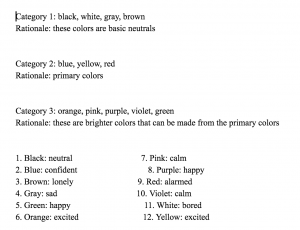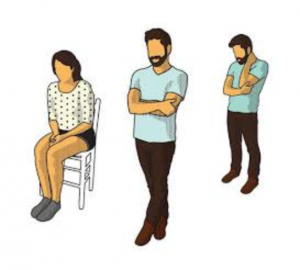Artifact 5
The Module 6 artifact was my favorite of all the exercises. I was asked to reflect on a significant experience from my childhood and how it shaped me into the adult that I am today. I chose the farmer’s market that my family worked at when I was growing up. This experience taught me so many valuable lessons while I worked alongside my family. We sold seafood that my dad harvested and I learned how to interact with the public and basic retail skills. I also learned how to use quickbooks, how to create basic marketing, and how to deal with hiring and firing employees. I definitely complained some during the early mornings and having to give up every Saturday during the summer but I truly believe that the skills I picked up over the years were worth the hassle. The visual below is a drawing of my family in the farmer’s market stand that we set up every Saturday during the summers for seven years.

Artifact 4
Artifact 4 asked me to find a partner and fill out a table and label a list of professions with the gender that I generally think of being related with that position. I had never thought of present day careers in gender roles but this exercise opened my ideas to the gender bias that I currently express. I chose male for the more technical careers such as mechanic, pilot, and architect while I chose women for the more creative careers such as dancer, make up artist, designer, and school teacher. In this course I’ve noticed that cultures from all over the world have these gender biases that are fairly similar. Women seen as more of the homemaker while men are generally the breadwinner such as lawyers and doctors. The visual below represents mine and my partner’s answers. There were no discretions between our answers, proving that most people view these same gender roles.

Artifact 3
The Module 10 artifact focused on how we value time and how those in other cultures value time in different ways. This corresponded with the Artifact which asked me to rate how long I would be willing to wait on different people in my life if they were late to meet me. I found that I would be more likely to wait longer for a professional peer than I would for someone such as a sibling. I am willing to wait for my boyfriend the longest because I know that he would never stand me up and respects my time. I believe that most cultures are willing to wait longer for someone in their professional life than anything. I am definitely not a confrontational person, so I am willing to wait so there is no conflict and I don’t have to confront them. I am also a fairly awkward person so I absolutely hate waiting around in public for someone and not knowing what to do with myself. This is shown below in the meme about being too awkward to wait alone.

Artifact 2
Module 11 focused on emotion in different cultures. For this artifact, I was asked to assign colors to different categories and give a reason. I grouped these colors with the neutrals, primary colors, and bright colors that are made by primary colors. Then, I was asked to couple specific colors with emotions. I chose the neutrals as boring or sad colors, the primary as strong emotions such as confident, and the bright colors as emotions that stem from emotions that the primary colors obtain, meaning these emotions are fairly strong. This lesson proved that colors are associated with certain emotions no matter what culture they are a part of. The visual attached is the groupings of colors and how I assigned each.

Artifact 1
Module 11 focused on Culture, Language and Communication and the corresponding artifact was about a Ted Talk on body language and how we come across. Generally, when we meet someone we judge them right off the bat even if we don’t actually mean to. We can judge harshly on body language alone and whether the person is open to interaction or presenting a closed off vibe. There is a whole science behind cortisol levels (stress) and body language. I tend to be stressed in my work life but feel that I am fairly good at covering this in public and giving away a confident facade in my professional life. I tend to adopt the role of confidence when I am playing the part of my job with high power positions and low power positions when in my everyday life. The below visual represents many of my low power poses that I am expressing daily in my personal life.
